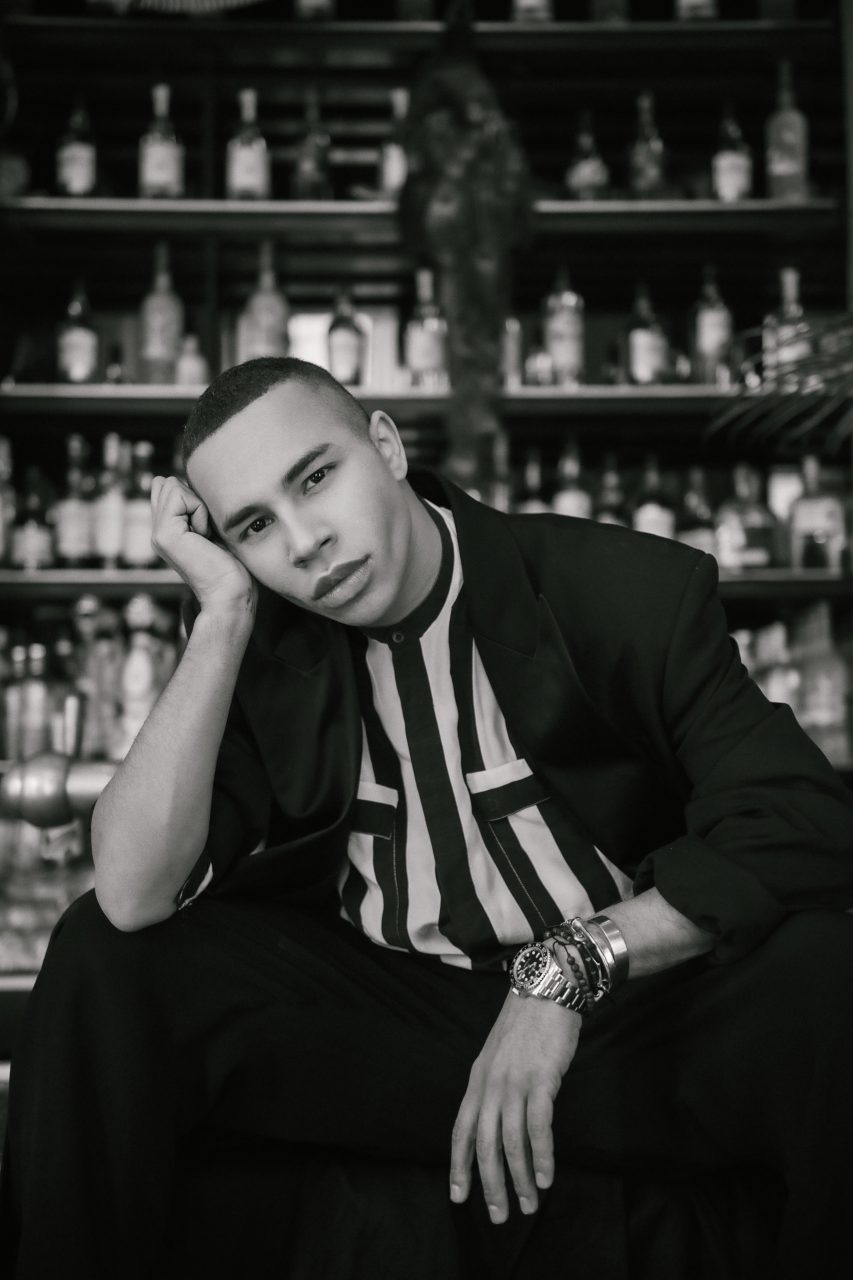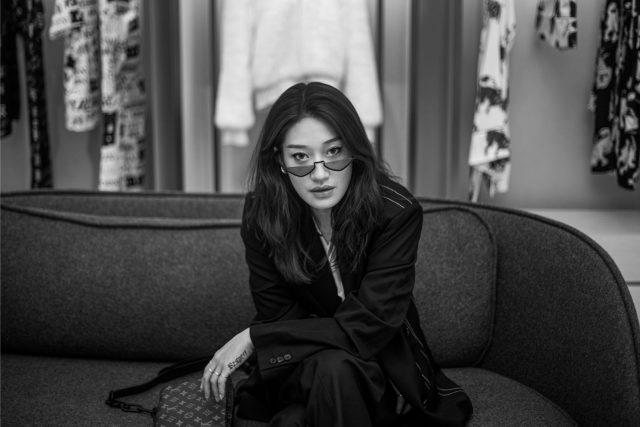Success came very very early for you, having been selected to head Balmain in your 20’s. How did you deal with the sudden spotlight and how do you keep yourself grounded?
“I think I stay grounded because, when I started Balmain, I was at the right hand of Christoph Decarnin, and I’ve had the same team from the beginning, that knew me not as a creative director, but as a friend. We started the Balmain story together and it helped for me to be amongst young people – youth, you know – and a good energy. There was no competition, no meanness between us. It was just like ‘we believe in the project, we believe in you.’ I have to say that, at Balmain, the most important thing is the respect for each other and I think that’s how we all kept our feet on the ground because we knew that success can come and leave as soon as it arrived.”
Fashion is a fickle world, and with social media, attention spans of people are even shorter. How do you ensure that people see the huge amount of work you and your team put in, and do not take fashion so lightly?
“I’ll tell you the truth. I think a lot of people think that Balmain, or I, are looking for attention. And that’s not the point of it. People pay attention to us because maybe we do something relevant, but I never try to catch attention. When I’m pushing diversity and inclusivity, and when I did my social media campaign with Pop culture, with Rihanna, Kim or Kanye, it was not to get attention, but more to be the witness of my time. I love being the witness of my time and I love to do things that I think are relevant for the brand and for the future. Subsequently, people sometimes call me disruptive or a rebel of fashion, but I never try to go against anything. I always try to be myself and maybe being yourself means that people pay you a lot of attention.”
Balmain has a very long and illustrious history, and at times things went a bit quiet. Which era of this venerable French house is your favourite and why?
“You know I think what I love about Balmain is that it’s a house that was born in 1945, after the Second World War, and it was creating silhouettes – – called the Jolie Madame silhouette – for strong women. The other part that I’m obsessed with is the diversity of the brand. Balmain dressed Dalida, Josephine Baker, Princess of Thailand, Audrey Hepburn, Brigitte Bardot. It had a panel of women that are really interesting and so diverse. The third point that I will always mention is that Mr. Pierre Balmain was strong in tailoring and so he could be really minimal and sharp. At the same time, he was incredible with couture and craftsmanship. If you think about it, Balmain today could be just as well known for the double-breasted jacket and a sharp suit and shoulder pads, as we could for craftsmanship and couture. I try to respect the DNA of the brand.”
You are surrounded by many celebrity friends, how do you view fame?
“You learn every day. You meet great people and you meet terrible people, but I think this is the story of life. At the end of the day, the beauty is in the cruelty as well because if you don’t see the cruel world you cannot see the incredible world. I became creative director of Balmain at 24 and had worked in fashion since I was 18, so I have seen the most beautiful side of fashion and I have seen the worst side of fashion. Fashion is a business, it’s not a family, and this is what I learned. One day you’re great, the day after they forget you. So you should be proud of what you do every day, knowing that maybe tomorrow everything could be over. What I think helped me is that I’m always unsatisfied. When you’re unsatisfied, you are always pushing yourself so much and challenging yourself every day. And that’s why maybe after 10 years I think I’m still relevant, because I’m never satisfied.”
Your designs are feminine and curvy yet the silhouette is very strong. What do you think defines the Balmain woman?
“I think the Balmain woman of today is a woman that is confident. It’s a woman that dares. She has no fear to be who she wants to be and whoever tells her otherwise, she will make sure that person does not belong in her world. She’s a woman that knows what she wants. She doesn’t need a man. She’s a strong, activist woman. She can be sexy, she can be glamorous, she can be super sharp, she can be super flamboyant. She’s just free. She’s a free woman and she will always be a free woman.”
We had the pleasure of dressing a famous Chinese actress, Shi Qi in Balmain for the cover of Vogue Hong Kong in July. What do you think makes Asian, or Chinese women, special?
I’m obsessed. I love China and I love Asia. I love Hong Kong. Every store that we open in Asia, I’m the first one to say ‘can I go?’ because I feel like every time I discover the culture more. What I love about Asian women is the elegance. I think there is so much elegance and sophistication and sometimes sexiness. There’s always a great balance. And another thing that I love is the mix between modernity and tradition, because Asia has incredible tradition architecture-wise, history-wise, but at the same time it’s a country that looks to the future. And I think this is what is incredible. It’s that mix between modernity and history, past and future.
You grew up in the beautiful surroundings of Bordeaux. What are some of your best childhood memories?
“When you go to Bordeaux you are surrounded by an incredible culture of history and I think this is what I love about my city and where I come from. There is the bridge that was built by Mr. Napoleon, there are the houses where François Mauriac was living in Montesquieu. The most incredible men that wrote the most incredible books that inspired my country actually came from Bordeaux. So I think that’s what I love about my city. I feel proud.”
What is your favourite city now? And why?
“Definitely my favourite city is Paris because I’m proud. I would say L.A. too, because there is something about L.A. that feels like endless opportunity. I love London because there’s always that kind-of-edgy feeling. There’s a lot of tradition and it’s aristocratic, but there’s always something grungy or punk-ish about it that I don’t have in Paris. I love Hong Kong because it’s the future. It’s all about modernity. I remember staying in this incredible hotel and watching the lights and it felt like I was almost in 2500. There’s a feeling that ‘this could be the future’. It’s almost like you are in a Netflix series for the future, and I love that. I love Doha in Qatar too, because you can see the mixture of cultures and you have the sea and the desert yet it’s really modern at the same time.”
You must travel a lot for your work. What are three stapes you never leave home without?
“My creams, because you need to moisturise your face. I love one that I bought in Asia actually – Sulwhasoo. So, I use La Mer, Sulwhasoo and Augustinus Bader. With the different climates around the world, it’s important that you really take care of your skin. So this is the first thing. The second thing would be my double-breasted jacket. No matter where I go, I need to have my double-breasted jacket. This is really important. And my candle. I always travel with a candle from Trudon, one of the oldest candlemakers in France, because I love to feel that the smell of my house is everywhere that I go.”
What do you most treasure in your life?
“I think I would say my freedom. This is priceless. I love waking up in the morning and feeling free to think, feeling free to be the one that I want to be. I think the priceless treasure that I have in my life is my freedom.”
Editor
Leslie ChanCredit
Lead photo: Griffin Lipson


